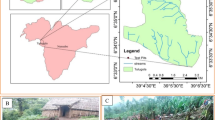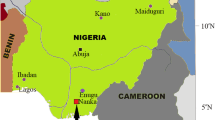Abstract
The causes of mass movement, which occurred on the 5th October 2021 at Tongo-Gadima and damage grouting drainage infrastructure of the national road, are examined in this paper, in order to set up the novel procedure for investigating landslide in an area with limited inventory geotechnical data. They are evaluated by estimating the annual precipitation on 12-year period and analyzing the relevant geotechnical parameters: water content, degree of saturation, consistency limits, grain size distribution, linear shear strength, uniaxial compressive strength, compressibility test on samples collected on the field in order to understand the behavior of lateritic soil exposed under rainfall as well as zonation of slopes. This investigation will, in turn, enable the stakeholders to implement appropriate mitigation measures across the landslide-induce area. The main characteristics such as concave slope, shallow slid surface occurrence, and rotational trend of Tongo-Gadima landslide were influenced by high annual rainfall reaching the average of 1540 mm. The zonation analysis identified steeping slope (> 20°) called escarpment landscape. High values of water content and degree of saturation induced the swelling behavior of unsaturated soil. It has high plasticity in the lower and median set made up of more than 30% fine clay. The internal friction angle and material cohesion showed poor characteristic 35° and 0.11 bar respectively. The low uniaxial compressive strength ranging between 1.77 and 7.87 MPa suggests that the complete meteoric weathering of rock and the Cc/(1 + e0) > 0.20 ratio confirms the very compressible property of soil. The evidence of thixotropic rheoliquefier pattern of the clay matric mixed with gravel and sand is detrimental when meteoric water infiltration transforms the material into landslide-prone mud under constraint. Poor drainage has considerably increased water saturation of clay particles in the prism of rupture and weak mechanical properties of soil have been at the origin of landslide in Tongo-Gadima. Instrumentation and monitoring of slope are the first action to be taken to mitigate landslide in the region.













Similar content being viewed by others
References
Achyut K (1992) Mass movement susceptibility of the area East of Manizales Cordillera Central Colombia. Dissertation, International institute for Aerospace survey and Earth Sciences, Delft-Netherlands
Asaah AV, Zoheir B, Lehmann B, Frei D, Burgess R, Suh CE (2015) Geochemistry and geochronology of the ~ 620 Ma gold-associated Batouri Granitoids, Cameroon. Int Geol Rev 57:1485–1509
Bitom D, Volkoff B, Seyler F, Ndjigui PD (2004) Rôle des héritages latéritiques et des sols en zone inter-tropicale forestière humide. C.R. Géosciences 336:1161–1170
Cho SE, Lee SR (2001) Instability of unsaturated soil due to infiltration. Comput Geotech 28:185–208
Collins BD, Znidarcic D (2004) Stability analyses of rainfall induced landslides. J Geotech Geoenviron Eng 130(4):362–372
Crosta G (1998) Regionalization of rainfall thresholds: an aid to landslide hazard evaluation. Environ Geol 35(2–3):131–145
Crozier MJ (1999) Prediction of rainfall-triggered landslide: test of the antecedent water status model. Earth Surf Proc Land 24:825–833
Dalmatov BI (1988) Mécanique des sols et fondations. Stroiizdat, Leningrad
Ekodeck GE, Kamgang KBV (2002) L’altérologie normative et ses applications : une expression particulière des roches alumino-silicatées du point de vue de leur évolution supergène. Collection Connaissance, Yaoundé
Flageollet JC (1989) Les mouvements de terrain et leur prévention. Masson, Collection géographie, Paris
Fourie AB, Rowe D, Blight GE (1999) The effect of infiltration on the stability of the slopes of ash dump. Geotechnique 49(1):1–13
Ganesh D, Romi G, Ranjan P, Sujan K (2023) Landslide susceptibility and risk analysis in the Benighat rural municipality, Dhadingn, Nepal. Nat Hazard Res 3(2):170–185. https://doi.org/10.1016/j.nhres2023.03.006
Hillel D (1971) Soil and water – physical princiles and processes. Academic Press, pp 131–165
Huat BBK, Ali FHJ, Low TH (2006) Water infiltration characteristic of unsaturated soil slope and its effect on suction and stability. Geotech Geol Eng 24:1293–1306
Iverson RM (2000) Landslide triggering by rain infiltration. Water Resour Res 36(7):1897–1910
Jin JQ (1992) Survey of landslide disaster of Shaanxi province in 1991. J Catastrophol 7(2):76–77
Khanal GP (2013) landslide susceptibility mapping of the Seti watershed between Bhimad and Damauli. Tribhuvan University, Western Central Nepal
Kim J, Jeong S, Park S, Sharma J (2004) Influence of rainfall-induced wetting on the stability of slopes in weathered soils. Eng Geol 75:251–262
Kouayep LS, Eko RM, Kamgang KBV, Wouatong ASL, Ngapgeu F (2009) The influence of rainfall on mass movements: the case of Bana West Cameroon. ISEV2009 2:822–829
Letourneur J, Michel R (1971) Géologie du genie civil. Collection U. Armand Collin, Paris
Li AG, Tham IG, Yue ZQ, Lee CF (2005) Comparison of field and laboratory soil-water characteristic curve. J Geotech Geoenviron Eng 131(9):1176–1179
Lumb PB (1975) Slope failure in Hong Kong. Q.J Eng Geol 8:31–65
Monteiro SN, Vieira CMF (2002) Characterization of clays from Campos dos Goytacazes. North Rio De Janeiro State Brazil. Tech Pap 18(3):152–157
Ng CWW, Shi Q (1998) A numerical investigation of the stability of the unsaturated soil slopes subjected to transient seepage. Comput Geotech 22(1):1–28
Nzenti JP, Badibanga KG, Wönen TRL (2006) Synkinematic emplacement of granitoids in a Pan-African shear zone in central Cameroon. J Afr Earth Sc 45:74–86
Philiponnat G, Hubert B (1997) Fondation et ouvrage en terre. Eyrolles
Rahardjo H, Lim TT, Chang MF, Fredlund DG (1995) Shear-strength characteristics of residual soil. Can Geotech J 32(1):60–77. https://doi.org/10.1139/t95-005
Robitaille V, Tremblay D (1997) Mécanique des sols (théorie et pratique). Modulo, Quebec-Canada
Tchakouté JN, Calistus GF, Ngamy KA, Metang V, Mvondo OJ, Nkoumbou C (2021) Petrology and geochemistry of the Pan-African high-K calc-alcaline to shoshonitic-adakitic Bapé plutonic suites (Adamawa-Yade block, Cameroon): evidence of hot oceanic crust. J Afr Earth Sc. https://doi.org/10.1007/s00531-021-02060-6
Tchotsoua M (1993) Erosio accélérée et contrainte à l’aménagement du site de la ville de Yaoundé. Une contribution à la gestion de l’environnement urbain en milieu tropical humide. Mémoire Université de Yaoundé I
Tu XB, Kwong AKL, Dai FC, Tham LG, Min H (2009) Field monitoring of rainfall infiltration in a loess slope and analysis of failure mechanism of rainfall-induced landslides. Eng Geol 105:134–150
Van Westen CJ, Castellanos E, Kuriakose SL (2008) Spatial data for landslide susceptibility, hazard, and vulnerability assessment: an overview. Eng Geol 102(3–4):112–131
Acknowledgements
The authors would like thank the board management of the National Civil Engineering Laboratory for the geotechnical analysis performed on soil samples and Mistress Feumba Jeanne for her financial support.
Author information
Authors and Affiliations
Corresponding author
Ethics declarations
Conflict of interest
The authors declare no competing interests.
Additional information
Responsible Editor: Zeynal Abiddin Erguler
Rights and permissions
Springer Nature or its licensor (e.g. a society or other partner) holds exclusive rights to this article under a publishing agreement with the author(s) or other rightsholder(s); author self-archiving of the accepted manuscript version of this article is solely governed by the terms of such publishing agreement and applicable law.
About this article
Cite this article
Sylvain, K.L., Philippe, S.A., Kenmoe, M.R.O. et al. Mass movement susceptibility: the case study of Tongo-Gadima landslide, East Cameroon. Arab J Geosci 17, 140 (2024). https://doi.org/10.1007/s12517-024-11938-z
Received:
Accepted:
Published:
DOI: https://doi.org/10.1007/s12517-024-11938-z




